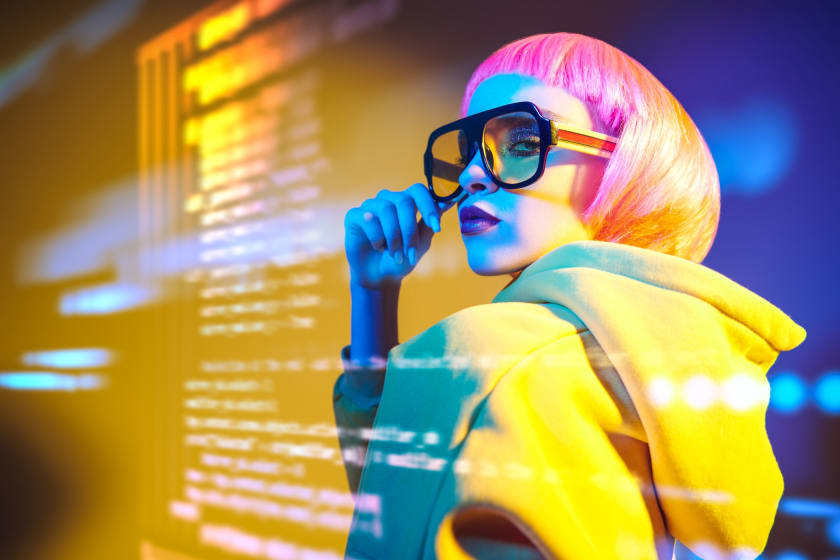Personalization, The Metaverse, and NFTs: Technology Fuelling The Next Phase of Fashion



The fashion world is shifting to a new phase propelled by the recent changes in technology. The creation of metaverse, a digital reality that anyone can create and modify, has built an active fashion consumer base that wants to buy digital clothes and desires to get those in physical form. This amalgamation of technology in fashion has created an environment favorable for the next big change in the fashion industry.
The Raging Tide Of Personalization
Personalization is a feature that many online shopping platforms offer to their users. Users can use personalization to navigate any e-commerce website easily. Features such as "You may also like..." on several e-commerce sites exemplify personalization. Personalization also helps sellers make huge profits by speeding up the decision-making process.
Analysis paralysis is a situation where shoppers find themselves overwhelmed by too many options. A study shows that almost 40 percent of customers leave e-commerce websites because there are too many options on the website. They were spoiled for choice and chose to leave the website without purchasing anything.
This problem only persists primarily in the fashion industry, as there are too many sizes, colors, and styles of clothes. For instance, gadgets are way more complex than clothes, yet consumers are not bogged down with too many options. Today, technology in fashion can resolve analysis paralysis quickly. However, implementing personalization also has too many challenges.
Challenges Faced During Personalization Of Fashion
Some of the significant challenges faced by fashion brands or e-commerce websites when implementing personalization are -

-Data Collection
Collecting data is one of the essential steps to personalize fashion. However, there are minimal resources to collect the data required to develop such a system. Shoppers can ask their customers to complete a quiz with the right fit, size, style, and price. However, these questionnaires will not suffice, as they cannot reflect the subjective behavior of customers.
-The Relevance Of Data
Personalization is a difficult task because the data on which companies will design such systems may not be relevant after some time. To become more relevant, fashion brands need to collect more and more data to fuel their system. The abundance of data will help companies predict customers' behavior better.
However, this data may also become irrelevant after some time. Anna Kuragina (of the H&M Group), who works on consumer-facing AI products, indicates that fashion trends do not remain constant in the modern world and customer choice is often unpredictable. Companies cannot afford preconceived notions based simply on what happened last year or last month.
-Algorithm Doesn't Know It All
One cannot rely on algorithms for every piece of information in the fashion world. For instance, an algorithm cannot state why a customer chooses a particular item. It can only predict based on customers' past preferences, which depend on subjective moods and occasions. But companies can employ techniques, like collaborative filters used by Amazon and Netflix, where they predict your choices based on choices made by people with preferences similar to yours.
Anna Kuragina of H&M Group believes that the collaborative filters may not work well for fashion brands. According to her, unlike other retail players such as grocery retailers, the fashion industry does not have a permanent assortment. Instead, they must continue to surprise their customers and yet, give relatable products.
Can Personalization Make A Difference?
Although personalization has some inherent flaws, it will play a major role in the future. The personalization technology in fashion needs to be so accurate that it can detect even the slightest change in customers' behavior and suggest clothes accordingly. Algorithms must understand the role of various variables, which even humans cannot comprehend. Such technology will bring a revolutionary change in the fashion world.
Is Metaverse Reshaping The Fashion World?

Many fashion brands, such as Gucci and Louis Vuitton, have launched their NFTs, named Garden Metaverse and Louis The Game, respectively. Metaverse has already started propelling fashion's next phase, where everyone has the freedom to create and modify their apparel.
Metaverse has given many fashion enthusiasts a chance to challenge the idea of fashion having limited functions. Customers are no longer passive but play an active role in fashion. People can build an imaginary world to showcase their creativity and design whatever they need. The CEO of Vue.ai - a company that gives an AI platform to users where they can modify the digital experience - says that metaverse is nothing but an expansion of the digital spaces around ourselves.
Metafashion
The rise of fashion platforms, such as DRESSX, allows consumers, fashion brands, both traditional and digital, to enter into the metaverse. This company offers innovative services, such as allowing consumers to manufacture clothes from scratch, buy virtual clothes, and convert their fashion NFTs into actual garments.
The main reason behind the popularity of these brands is that the clothes they offer are traceable and impossible to copy, which gives these clothes the same status as any high fashion. More brands such as Fabricant are selling virtual clothes, and recently Fabricant sold one of their pieces called Iridescence for 9500 dollars.
Natalia Modenova, the founder of DRESSX, states, "The metaverse creates a great opportunity for the industry to get to the next level." According to her, the metaverse creates new markets and integrates with a digital creator economy.
The Growing Popularity Of Fashion NFTs
NFTs stand for non-fungible tokens, meaning that they are unique and cannot be replicated. It's this uniqueness that makes an NFT popular among people. NFT has also entered the fashion industry as a digital version of luxury fashion. Moreover, it gives consumers the option to create their designs and express themselves freely through their clothes.
NFTs also allow people to make something that will exist for eternity. It can also act as a social asset that consumers can trade. The sense of ownership has also played a crucial part in making NFTs way more popular than they are.
With its rising popularity, brands such as DRESSX have employed blockchain technology in fashion to create a platform where users can create and sell fashion NFTs and get them in physical form.
NFTs have also changed advertisements. Consumers have become more interested in the origin of brands, as they are interested in the origins of NFTs. Fashion brands are modifying their marketing strategies and designs based on the changes in the NFT space.
Hence, we can say that brands are now shifting towards a new phase where they are taking several measures to meet the demands of the new generation, which shows a great interest in NFTs and metaverse. Moreover, using personalization technology in fashion, brands can benefit by increasing their sales manifold.
Want to source clothes for your brand? Get in touch with Fashinza now.



















